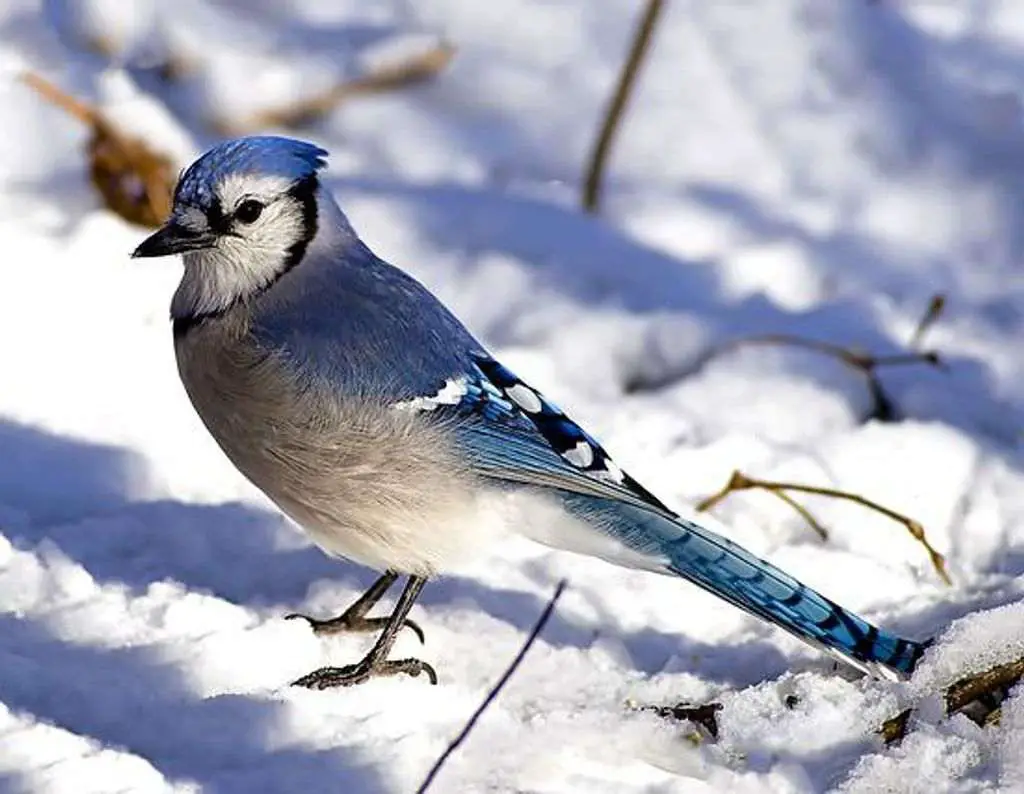As winter approaches, many bird species begin a remarkable journey to seek out warmer climates where they will spend the cold season. The phenomenon of bird migration has fascinated scientists and bird enthusiasts for centuries, as it is a natural behavior that remains largely mysterious.
Birds migrate to escape the harsh weather conditions, find better food sources, and seek out more favorable nesting opportunities. The process of migration takes a considerable amount of energy and requires precise navigation skills. Some bird species travel thousands of miles to reach their wintering grounds, following established migration routes that have evolved over generations.
Table of Contents
- 1 Key Takeaways:
- 2 Where Do Birds Go When It Gets Cold?
- 3 Bird Migration: A Natural Phenomenon
- 4 Wintering Birds: Seeking Warmer Climates
- 5 Cold Weather Adaptations: Surviving the Chills
- 6 Hibernation: A Rare Strategy Among Birds
- 7 Bird Behavior in Winter: Energy Conservation and Feeding Tactics
- 8 Migration Routes: A Marvelous Journey
- 9 Birdwatching and Citizen Science: Observing Wintering Birds
- 10 Human Impact: Conservation and Preservation Efforts
- 11 Conclusion
- 12 FAQs: Where Do Birds Go When It Gets Cold?
- 12.1 Where do birds go when it gets cold?
- 12.2 What triggers bird migration?
- 12.3 Where do birds spend the winter?
- 12.4 How do birds survive in cold weather?
- 12.5 Do birds hibernate during the winter?
- 12.6 How do birds navigate during migration?
- 12.7 How can I observe wintering birds?
- 12.8 What can I do to help bird conservation during the winter?
- 13 Author
Key Takeaways:
- Birds migrate to escape cold weather, find better food and nesting opportunities.
- Migratory birds undertake incredible journeys, sometimes traveling thousands of miles.
- The process of migration requires energy and precise navigation skills.
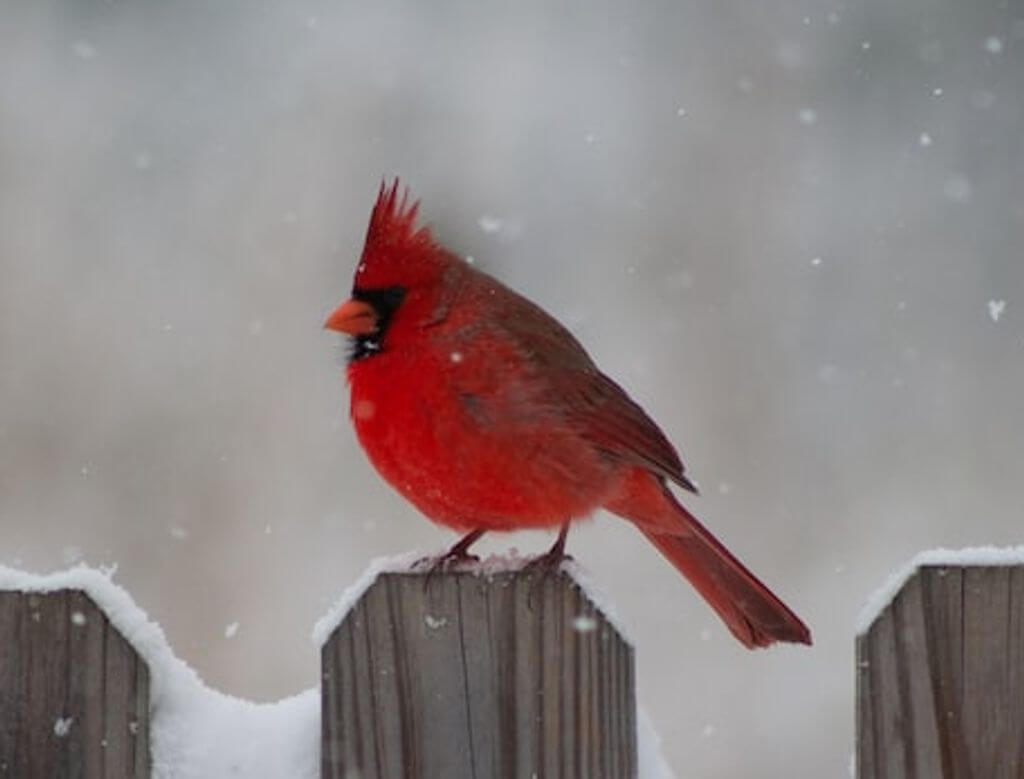
Where Do Birds Go When It Gets Cold?
When temperatures drop and winter sets in, many bird species migrate to warmer climates in search of food and suitable habitats. Some birds travel thousands of miles to reach their wintering grounds, while others simply move to lower elevations or more sheltered areas.
Common wintering destinations for birds include the southern United States, Mexico, Central and South America, and the Caribbean. Additionally, some bird species may remain in their breeding range during the winter months if they are able to find suitable food and shelter.
Overall, the specific wintering destinations of birds will depend on a variety of factors, including geography, climate, and habitat availability.
Bird Migration: A Natural Phenomenon
Bird migration is a natural behavior for many bird species, triggered by factors such as seasonal changes and the need for better food and nesting opportunities. Migration is an impressive phenomenon, with some birds traveling thousands of miles to reach their wintering grounds.
Bird Winter Migration Routes
During the winter, many birds leave their summer homes and travel to other areas with milder climates. For some species, this means traveling south to warmer parts of the globe. Others remain in their home ranges but move to lower elevations to escape the harshest winter weather.
The migratory route that birds take varies depending on the species and their wintering grounds. For example, some birds fly from the Arctic to South America, while others fly across the Atlantic Ocean from Europe to Africa. The route taken by each bird is influenced by factors such as wind patterns, food availability, and geographic features.
Scientists have used a variety of methods to track bird migration, including satellite telemetry and banding programs. By studying migration patterns and routes, researchers can better understand the challenges that birds face during their journey and the importance of preserving habitats along their migration path.
In the next section, we’ll explore the different wintering habitats that birds seek out to escape the cold.
Wintering Birds: Seeking Warmer Climates
In order to escape the harsh conditions of winter, many bird species seek out warmer climates where they can safely spend the colder months. Some birds travel great distances to reach their wintering grounds, while others remain closer to home but still undertake significant journeys to reach suitable habitats.
Many birds prefer wetlands, coastal areas, and forests as wintering grounds. Wetlands provide ample food sources such as insects, fish, and amphibians, while coastal areas offer protection from strong winds and access to food like berries, seeds, and fish. Forests offer shelter and plenty of food sources including insects, seeds, and fruits.
| Preferred Wintering Grounds | Examples of Bird Species |
|---|---|
| Wetlands | Great Blue Heron, Wood Duck, Sandhill Crane |
| Coastal areas | Piping Plover, Snowy Owl, Laughing Gull |
| Forests | Dark-eyed Junco, Black-capped Chickadee, Red-tailed Hawk |
Some bird species also seek out urban and suburban habitats during winter, where they can find food and shelter in gardens, parks, and bird feeders. However, these areas may pose risks to birds due to exposure to predators, toxins, and collisions with buildings and vehicles.
Wintering in Flocks
During winter, many bird species flock together for warmth and protection. Flocking can also provide benefits such as increased opportunities for finding food sources and better detection of predators. Some birds form mixed-species flocks, where different species join forces and share information about food sources and predator threats.
Cold Weather Adaptations: Surviving the Chills
Birds exhibit a range of adaptations to survive in cold weather conditions. Physiologically, one of the most effective measures is growing thicker feathers to insulate their bodies against the cold. Additionally, birds increase their fat reserves, which serve as an energy source to maintain their body temperature.
Behavioral changes in cold weather also help birds survive. One such change is flocking together for warmth. This behavior provides increased protection from the wind and exposure to the cold. It also allows birds to share body heat, reducing their individual energy expenditure.
Another adaptation is reducing their activity levels to conserve energy. Some bird species enter a state of torpor during the night, where their metabolic rate drops significantly to reduce energy consumption. In the daytime, they increase their activity levels to forage for food before returning to torpor in the evening.
Hibernation: A Rare Strategy Among Birds
While many animals hibernate during the winter months, it is a rarity among birds. Only a few species, such as the Common Poorwill and the Ruby-throated Hummingbird, have been observed entering a state of torpor during the colder months.Why do some birds hibernate?
In most cases, birds that hibernate during winter do so because they cannot find enough food during the colder months. By lowering their metabolic rate and entering a state of torpor, they are able to conserve energy and survive on less food.How does hibernation affect birds?
During the torpor state, a hibernating bird’s body temperature drops significantly, its heart rate slows, and its breathing becomes shallow. This allows the bird to conserve energy, but it also makes it vulnerable to predators and other risks.What are the benefits of hibernation for birds?
For those birds that do hibernate, the benefits of torpor are clear. By conserving energy and surviving on less food, they are better equipped to make it through the winter months. They also reduce their risk of starvation and other threats that can arise when food is scarce.
Bird Behavior in Winter: Energy Conservation and Feeding Tactics
Winter is a challenging time for birds, and they have to adapt their behavior to conserve energy and survive in the cold weather. Some of the behavioral changes that birds exhibit during this period include reducing activity levels and using strategic feeding tactics to find food sources in colder climates.
One common behavior seen in winter is flocking together for warmth. By huddling together, birds can conserve energy and maintain body heat, especially during the night when temperatures drop. Some bird species also reduce their activity levels, including flying and singing, to conserve energy.
Another change that birds exhibit during winter is their feeding tactics. As food sources become scarce in colder climates, some birds switch to alternative food sources, such as seeds, berries, and insects. Some bird species also store food in hidden locations to ensure a steady supply of food during the winter.
“Birds have evolved a variety of feeding tactics to survive the scarcity of food in winter. Some species switch to alternative food sources, while others store food in hidden locations.”
Birds also have to increase their fat reserves during the winter to provide energy for their bodies. To achieve this, some birds adapt by growing thicker feathers to trap air and provide insulation. They also regulate their body temperatures to conserve energy and survive in the cold weather.
Overall, the behavioral changes and adaptations that birds exhibit during winter help them to conserve energy and survive in challenging conditions. Understanding how birds behave in winter is crucial in preserving their populations and habitats, which is why researchers and birdwatchers alike continue to study and document their behaviors.
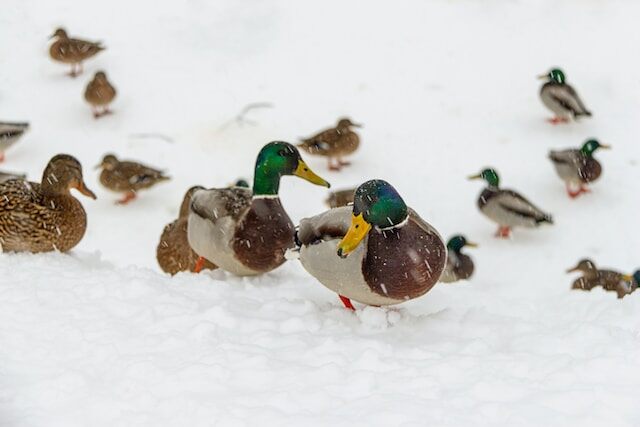
Migration Routes: A Marvelous Journey
During winter migration, birds undertake an incredible journey to reach their wintering grounds, covering thousands of miles across continents and oceans. The concept of migration routes is central to understanding how these birds navigate and overcome the various challenges they encounter along the way.
Birds follow distinct migratory flyways, which are routes that provide optimal weather conditions, food sources, and rest areas. There are four major flyways in North America: the Pacific Flyway, the Central Flyway, the Mississippi Flyway, and the Atlantic Flyway. Each flyway has specific stopover points where birds rest and replenish before continuing their journey.
| Migration Facts | Information |
|---|---|
| Challenges faced by migratory birds | Some challenges faced by migratory birds include navigating through unfamiliar territory, avoiding storms and predators, and finding enough food and water along the way. |
| The role of celestial cues in bird navigation | Many migratory birds use celestial cues, such as the position of the sun and stars, to orient themselves during their journey. |
| The importance of stopover sites | Stopover sites are critical for migratory birds to rest, feed, and prepare for the next leg of their journey. The loss of these habitats can have significant impacts on bird populations. |
It is truly remarkable to consider the endurance and resilience of these birds as they make their long and perilous journey to survive the winter months.
Birdwatching and Citizen Science: Observing Wintering Birds
Birdwatching is a popular hobby, attracting enthusiasts of all ages who are fascinated by the beauty and behavior of birds. Winter is an excellent time to observe birds, as many species gather in large flocks and can be easily spotted in their wintering habitats.
By observing bird behavior in winter, birdwatchers can contribute to citizen science initiatives aimed at studying bird populations and their winter survival strategies. This information is crucial to better understand the effect of human impact, such as habitat destruction, on bird migration and winter habitats.
Through citizen science initiatives, birdwatchers can submit their sightings and data to research organizations and help collect valuable information on bird behavior, migration patterns, and habitat use. This information can then be used to inform conservation efforts and ensure the preservation of habitats necessary for bird survival during the cold season.
Not only does birdwatching contribute to scientific research, but it is also an enjoyable activity that allows individuals to disconnect from technology and connect with nature. It is a great way to appreciate the remarkable adaptations and survival strategies developed by birds to withstand the challenges of winter.
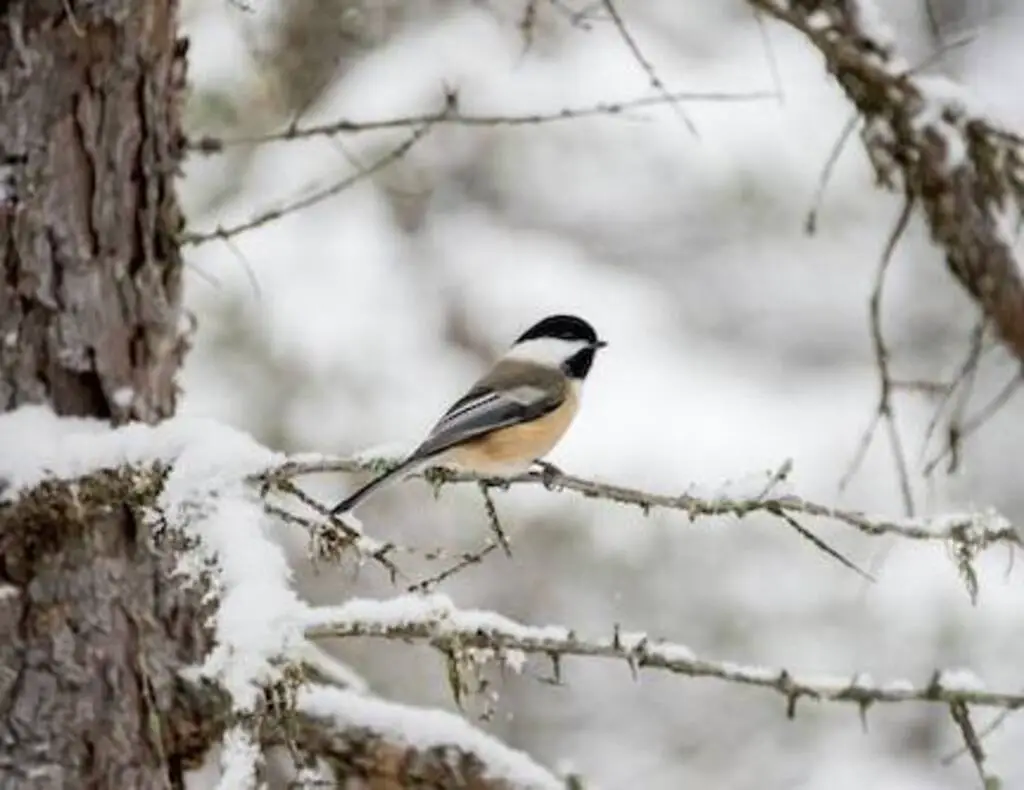
Human Impact: Conservation and Preservation Efforts
The survival of birds during winter months is closely tied to the availability of suitable habitats and food sources. However, many bird habitats are under threat due to human activities such as deforestation, overfishing, and climate change. As a result, conservation and preservation efforts are crucial in ensuring the well-being of bird populations during the cold season.
Protecting and restoring wetlands, coastal areas, and forests can provide essential wintering grounds for many bird species. Additionally, measures such as reducing pesticide use and promoting sustainable agriculture can ensure an adequate food supply for birds during winter.
Conservation efforts also play a critical role in preserving migration routes for birds. Many birds rely on specific stopover sites during migration, where they rest and refuel before continuing their journey. By protecting these sites, we can help ensure the successful completion of migration for many bird species.
Finally, citizen science initiatives such as birdwatching and monitoring programs can provide valuable information on bird behavior and populations during the cold season. This information can help guide conservation efforts and ensure the long-term survival of birds in winter.
Conclusion
As winter descends, birds embark on a remarkable journey to seek out warmer climates and better food sources. While some species migrate thousands of miles, others hunker down in their wintering grounds, utilizing various strategies to survive the cold.
Through the incredible process of migration, birds have adapted to take advantage of resources across different locations and ecosystems. Coastal areas, wetlands, and forests all play vital roles in providing winter habitats for many bird species.
In order to survive the harsh winter conditions, birds have evolved a range of remarkable adaptations. They grow thicker feathers, increase fat reserves, and adopt new behaviors, such as flocking together for warmth and conserving energy.
While hibernation is rare among birds, some species do enter a state of torpor during the cold season to save energy. But for the most part, birds rely on their remarkable winter survival strategies to endure the cold.
Observing bird behavior in winter is a great opportunity for birdwatchers to contribute to citizen science initiatives and learn more about the natural behavior of birds. And as we continue to work towards preserving and protecting habitats vital for bird migration and winter survival, we can ensure the well-being of these fascinating creatures for years to come.
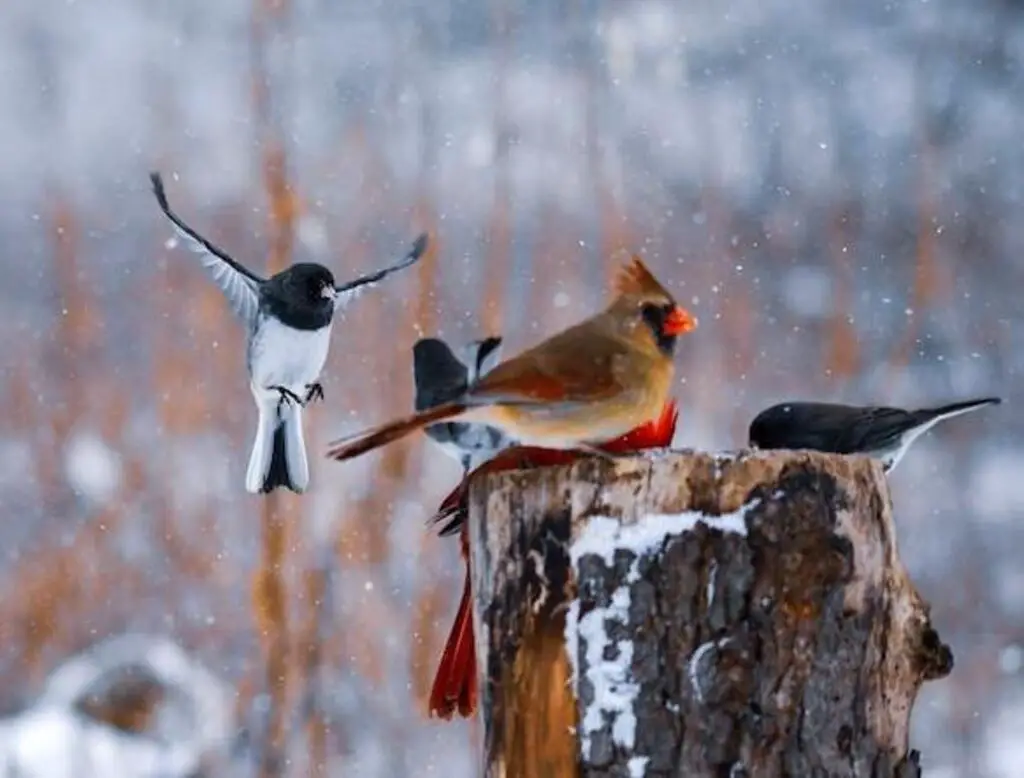
FAQs: Where Do Birds Go When It Gets Cold?
Where do birds go when it gets cold?
Birds have various strategies for surviving the cold season. Some species migrate to warmer climates, while others seek out suitable winter habitats. They may also adapt physiologically and behaviorally to cope with the cold.
What triggers bird migration?
Seasonal changes, such as temperature and daylight, play a significant role in triggering bird migration. Birds migrate in search of better feeding and nesting opportunities, as well as to escape harsh weather conditions.
Where do birds spend the winter?
Birds winter in a variety of habitats, depending on their species and preferences. Wetlands, coastal areas, and forests are common wintering grounds for many bird species, providing them with food, shelter, and protection from the cold.
How do birds survive in cold weather?
Birds have developed several adaptations to survive in cold weather. These include growing thicker feathers, increasing fat reserves, and engaging in behaviors such as flocking together for warmth. They also conserve energy and use strategic feeding tactics to find food sources.
Do birds hibernate during the winter?
Hibernation is rare among birds. While some bird species do enter a state of torpor during the cold season, most birds rely on other survival strategies such as migration, adaptations, and behavioral changes.
Birds have remarkable navigation abilities. They use celestial cues, landmarks, and Earth’s magnetic field to navigate during migration. Some species even possess an innate sense of direction that guides them to their wintering grounds.
How can I observe wintering birds?
Birdwatching is a popular activity for observing wintering birds. You can visit suitable habitats, such as wetlands or forests, and look out for bird species in their winter plumage. Participating in citizen science initiatives can also contribute valuable data on bird behavior in winter.
What can I do to help bird conservation during the winter?
You can support bird conservation by preserving and protecting habitats crucial for bird migration and winter survival. Participate in initiatives that promote habitat conservation, reduce light pollution, and provide food and water sources for birds during winter.


